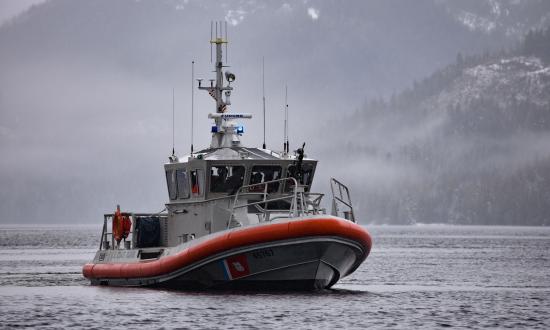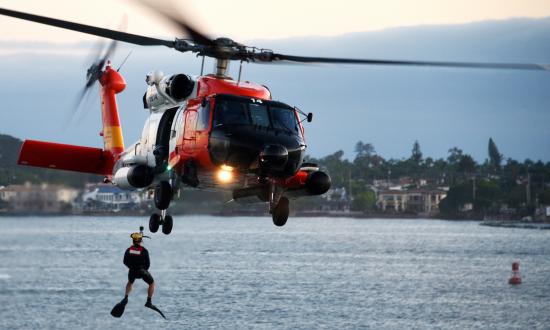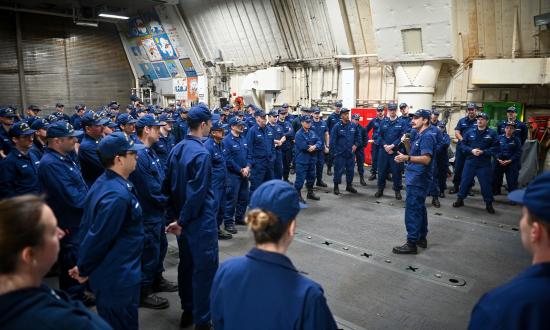In early November 2019, four U.S. Coast Guard units from the service’s deployable specialized forces (DSF) participated in a two-day full-scale exercise called Neptune Guardian in San Diego, California. This was the first multi-DSF short-notice maritime response designed to test interoperability and provide critical training for DSF units in the Coast Guard’s Pacific Area. A 111-foot vessel was contracted as the offshore platform for the exercise, and the scenario involved interdicting a vessel suspected of smuggling migrants, drugs, and military-grade weapons. A mission of this magnitude required expertise on multiple fronts to detect and neutralize the threat, conduct at-sea space accountability, and clear hazardous spaces.
While this exercise, coupled with real-world missions, is not new to the Coast Guard, it reaffirmed the concept of DSF units working in tandem to protect U.S. interests and prevent illicit contraband from entering the country. For example, in May 2018, the Coast Guard interdicted a 494-foot vessel suspected of carrying illicit contraband approximately 300 nautical miles off the coast of Guatemala.1 After several days of law enforcement operations at sea, the vessel was escorted to Puerto Quetzal, Guatemala, where the Coast Guard, along with marines from the Guatemalan Defense Ministry, seized more than three tons of cocaine. Both Coast Guard Tactical Law Enforcement Team Pacific and the Pacific Strike Team, two of the six types of DSF units, played a major role. The teams conducted at-sea space accountability and entries into confined space environments to identify hazards and assisted with locating the contraband.
What Neptune Guardian did demonstrate, however, is that the Coast Guard needs to exercise the use of DSF units in tandem more regularly.
Exercising Four DSF Units
The Coast Guard’s DSF units maintain unique capabilities across a wide range of missions and are worldwide deployable.2 Tactical law enforcement teams (TacLETs) perform critical law enforcement, counterdrug, and counterpiracy operations on board U.S. Navy and allied vessels. Maritime security response teams (MSRTs) conduct advanced and highly capable counterterrorism, law enforcement, and chemical, biological, radiological, and nuclear response and detection missions. Maritime safety and security teams (MSSTs) perform critical waterside and shoreside security operations. National strike force units provide hazardous material entry, identification, and sampling capabilities in enhanced chemical-protective clothing. The Neptune Guardian exercise was a unique opportunity to use a vast majority of DSF capabilities. Port security units and regional dive lockers, while also part of the DSF, were not involved in this exercise. However, both units have specific capabilities that would be a contributor and force multiplier for future exercises and missions depending on the nature of the incident or threat.
Once information from Coast Guard intelligence sources came in, the MSRT West mission commander initiated a request for forces to mobilize all relevant units. In less than 24 hours, the four DSF units reported to the staging area, discussed tactics, reviewed protocols, and planned operations.
Afterward, the exercise began. MSRT West mobilized and performed advanced interdiction and neutralization of any immediate threat offshore. As the 111-foot vessel was brought in, MSST Los Angeles/Long Beach provided multiple tactical small boats, which enforced a critical waterside security zone to protect the boarding team and keep the vessel from harming the public. TacLET Pacific embarked to provide additional law enforcement support and at-sea space accountability. On discovery of a potential hazardous space, the law enforcement detachment reached out to the Pacific Strike Team (PST) for assistance. The PST, with the assistance of additional MSST boats, embarked the vessel. Once on board, PST members entered a hazardous space and used their chemical-detection equipment to characterize and clear the atmosphere of any hazards. This exercise also allowed the PST to practice an emergency rescue drill on a team member exposed to hazardous materials and needing immediate evacuation. After the exercise concluded, a debrief with lessons learned was conducted, and all training objectives were met.
None of this would have been possible without key logistics and communication capabilities provided by Deployable Communications Forces (DCF) West. Although DCF West is not part of the DSF, it played a critical role. The DCF’s trailer, along with key equipment, operators, and technical specialists, were critical tools. The trailer provided command-and-control capability and was large enough for leadership positions, liaison officers, and subject-matter experts from the multiple DSF units to interface and communicate. This exercise’s success resulted from careful planning, coordination, and collaboration of all units.
As transnational criminal organizations become more creative and take greater risks to conceal contraband in potentially hazardous and confined spaces, it is critical the Coast Guard enhance its capabilities to respond to emerging maritime security threats.
1. Christopher Woody, “The U.S. Coast Guard Helped Make a ‘Historic’ Cocaine Bust at a Busy Drug Trafficking Hub,” Business Insider, 9 May 2018.
2. U.S. Coast Guard Publication 3-0, Operations (February 2012), 29.







